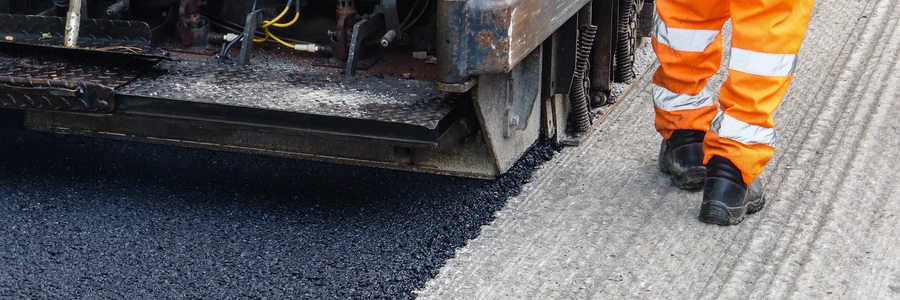The Buzz on A1 Professional Asphalt & Sealing Llc
The Buzz on A1 Professional Asphalt & Sealing Llc
Blog Article
The 8-Second Trick For A1 Professional Asphalt & Sealing Llc
Table of ContentsFacts About A1 Professional Asphalt & Sealing Llc RevealedThe smart Trick of A1 Professional Asphalt & Sealing Llc That Nobody is DiscussingFacts About A1 Professional Asphalt & Sealing Llc UncoveredHow A1 Professional Asphalt & Sealing Llc can Save You Time, Stress, and Money.Getting My A1 Professional Asphalt & Sealing Llc To Work

The oil in a car engine is not just oil. The REOB contains all the additives that were in the waste oil as well as the wear steels from the engine (generally iron and copper).
By making numerous blends using various REOB samples and various asphalt binders, the variants mostly can be averaged out. Several States gave examples of known REOB structure to TFHRC scientists, that evaluated the examples to contrast the portion of added (known) REOB to the located (evaluated) quantity. The evaluations showed a similar percent of included and found REOB.
The 10-Second Trick For A1 Professional Asphalt & Sealing Llc
None of those States understood that the asphalt they were buying had REOB. One State insisted its examples had no REOB - https://padlet.com/a1asphaltsealng/my-stellar-padlet-8k4iv5oxbxezxc6c.
Of the 1,532 examples tested, 12 percent consisted of REOB, and some contained appreciably high degrees of it at 1020 percent. The highest degree was 34 percent in an example from Texas, which TxDOT had actually used in a patching compound. This screening likewise exposed the existence of phosphoric acid in 11 percent of the samples, and 2 percent contained ground tire rubber.
Two years back at TRB's yearly conference, the Federal researchers held an REOB workshop and presented the findings of their lab examinations to a standing room-only group. Although some agencies do not specifically outlaw REOB, they do enforce physical tests that preclude its useeffectively a restriction. asphalt sealcoating in st louis. Others do not prohibit it by specification, however have agreements with asphalt vendors to stay clear of making use of REOB
All About A1 Professional Asphalt & Sealing Llc
A handful do enable REOB, some within specific limitations. For instance, Ohio and Texas limitation levels to much less than 5 percent of the asphalt. To establish a reliable examination approach that all States can make use of, the TFHRC researchers established up a round-robin examination plan. The individuals are 11 State freeway companies (Illinois, Massachusetts, Minnesota, Mississippi, Montana, North Carolina, Oklahoma, South Carolina, Texas, Vermont, and Wyoming), 2 independent testing labs, the Ministry of Transport in Ontario, Queen's College in Ontario, and an Ontario paving service provider.
The individuals are testing the samples individually utilizing the standards offered by the TFHRC scientists. The output will be a suggested AASHTO examination method that any kind of State can take on and utilize.
The pavement with REOB, which lies 0.6 mile (1 kilometer) from the pavement without REOB, has similar subgrade, traffic thickness, and climate. Nonetheless, the segment of Highway655 with 5 to 10 percent REOB revealed substantial breaking. In this example, the visibility of REOB was i was reading this the determined root cause of splitting at a reduced temperature levels.
A section of examination pavement in Minnesota (MN1-4) discovered to have REOB also broke prematurely. The pavement done well for the initial 3 to 4 years, however after that began to split.
The 6-Second Trick For A1 Professional Asphalt & Sealing Llc
The tests were not extensive, but they showed that at degrees of 6 percent or even more, the tensile stamina of the asphalt dropped substantially. At a level of 3.5 percent REOB, the variant in the physical test approaches was above the effect of REOB. Actually, it was hard for scientists to evaluate whether REOB was existing.

One binder parameter considered is the distinction between the reduced temperature essential requirements temperature level for tightness (S) in the bending light beam rheometer and the flexing beam of light rheometer creep incline (m-value) kept in mind as Tcritical. TC = TC (S) TC (m-value). Analysis of this parameter is still continuous. Two independent research teams, one from AASHTO and the other from the Asphalt Institute, ended that even more research study is needed on using REOB in asphalt.
Previously, all asphalt screening gauged design buildings such as tightness. These tests do not show what products had been contributed to the asphalt. One sample obtained throughout the TFHRC research had an extremely unusual evaluation. The example had the adhering to examination outcomes: Superpave PG 64-28 with a heat grade of 67.3 Tcritical on the bending beam rheometer was 6.7 degrees Celsius.

The smart Trick of A1 Professional Asphalt & Sealing Llc That Nobody is Discussing
These outcomes show there are weak points in the standardized engineering testing protocols that might be exploited. The manufacturer might have a financial advantage and the item passes all the standard tests, however the item might not be helpful to making certain long-term efficiency. To address this problem and the expansion of brand-new asphalt additives and extenders, TFHRC is beginning a research study program to utilize portable spectroscopic gadgets, x-ray fluorescence spectroscopy, and Fourier change infrared spectroscopy to make it possible for analyses to be done in the field instead than having to take examples back to the lab.
Report this page